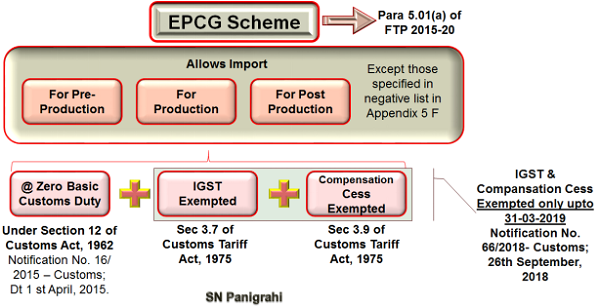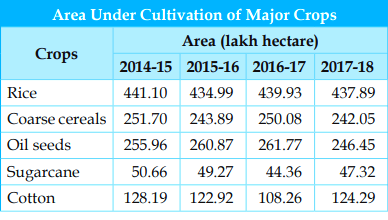International Relations
India-Finland Relations
For Prelims: Quantum Computing, Sustainable Energy Technologies, Electric Vehicles, Cyber-Physical System, Quantum Technologies, Future Manufacturing, Green Hydrogen Fuel
For Mains: Bilateral Groupings & Agreements, Effect of Policies & Politics of Countries on India's Interests, India-Finland Relations, Bilateral Groupings & Agreements
Why in News?
Recently, Finland’s Minister of Economic Affairs met India’s Union Minister of State Science & Technology.
- They announced the decision to establish an Indo-Finnish Virtual Network Centre on Quantum Computing.
- The Indian side has identified three premier institutes viz IIT Madras, IISER Pune and Centre for Development of Advanced Computing (C-DAC) Pune for Virtual Network Centre on Quantum Computing.
What are the Highlights of the Meeting?
- India is keen to develop research collaborations with Finnish R&D institutions and technology collaboration with Finnish Industry especially focusing on the following technology domains and application of Quantum Computing in areas such as:
- Sustainable Energy Technologies (generation, conversion, storage and conservation), Environment and Clean Technologies,
- Biobased Economy, BioBanks and Biobased materials for different applications,
- Water and Marine Technologies,
- Food & Agri Technologies,
- Affordable Healthcare (including, Pharmaceuticals and Biomedical Instrumentation),
- Technologies for Advanced Manufacturing, Integration of Artificial Intelligence and Machine Learning in all domains.
- The Department of Science & Technology has initiated several new mission mode programs like Electric Vehicles, Cyber-Physical System, Quantum Technologies, Future Manufacturing, Green Hydrogen Fuel etc and sought joint collaboration with Finland in solving issues of societal challenges.
- The visiting Finnish Minister assured that Finnish companies will partner with India for Carbon-neutral technologies and enhance cooperation for Sustainability in Climate Change.
- The Finnish Minister also invited India to explore the possibility of deeper cooperation in Finland’s Biobank project to mediate high-quality human samples for medical research to promote the development of new products and services that promote public health.
What is the History of India-Finland Relations?
- Background: Finland and India have traditionally enjoyed warm and friendly relations.
- In recent years, bilateral relations have acquired diversity with collaboration in research, innovation, and investments by both sides.
- 2019 marked 70 years of diplomatic relations between the two countries.
- Each Other’s Importance: Finland sees India as a market for its products and a favourable investment destination for its high technology industries.
- India views Finland as an important member of the European Union and a repository of modern technology.
- S&T Collaboration: India and Finland have strong bonding in Science, Technology and Innovation.
- Both India and Finland are consultative members of the Antarctic Treaty and have active stations in Antarctica.
- Finland would be hosting the Antarctic Treaty Consultative Meeting (ATCM) in 2023 and India in 2024.
- India Meteorological Department (IMD) and the Finnish Meteorological Institute (FMI) have been cooperating in the field of Atmospheric Environment since 2014.
- Under this collaboration, Air Quality Forecasting models developed by FMI are customised for the Indian region resulting in the enhanced capability to forecast pollution events from microscale to regional scale so that pollution control authorities can take appropriate action.
- Finland is a leader in 5G/6G technology and Top Indian IT companies are looking to collaborate in this sector.
- Both India and Finland are consultative members of the Antarctic Treaty and have active stations in Antarctica.
- Economic and Commercial Relations:
- In 2020, India’s total trade (goods and services) with Finland was USD 2.3 billion which is in India’s favour.
- Trade-in goods in 2020 were approximately USD 950 mn and were in Finland’s favour by approximately USD 134 million.
- Finland’s top imported goods from India (Jan-Dec 2020):
- Medicinal, pharmaceutical products
- Articles of apparel and clothing accessories
- Textile yarn, fabrics, made-up articles
- Manufactures of metals
- Electric machinery and parts
- India’s top imported goods from Finland (Jan-Dec 2020):
- Machinery for special industries
- Electric machinery and parts
- Paper, paperboard and articles thereof
- Metalliferous ores and metal scrap
- General industrial machinery
- Cultural Relations:
- Finland is very receptive to Indian culture.
- There are several Indian dance schools and Yoga schools.
- Cultural events are organised regularly by Indian Associations and other cultural organisations promoting Indian dance and music (both classical as well as contemporary).
- Finnish India Society has been active since 1956.

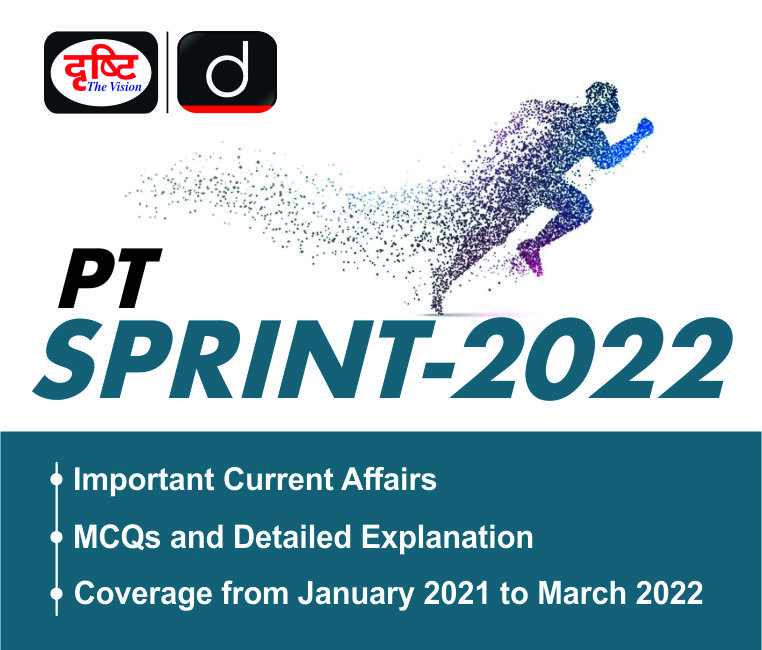
Governance
Global Centre for Traditional Medicine: Gujarat
For Prelims: GCTM, WHO, Traditional Medicine, Artificial intelligence
For Mains: Global Centre for Traditional Medicine (GCTM) and its significance, Traditional Medicine
Why in News?
Recently, the groundbreaking ceremony was performed for the first-of-its-kind World Health Organization (WHO) Global Centre for Traditional Medicine (GCTM) in Jamnagar, Gujarat.
- Additionally, the Global Ayush Investment and Innovation Summit will be held later this month in Gandhinagar which is aimed at increasing investments and showcase innovations in the field of traditional medicine.
- It is a unique attempt to foster long-lasting partnerships, boost exports and nurture a sustainable ecosystem.
What is the Purpose for establishing GCTM?
- Integrating with Technological Advancements:
- The Centre aims to channel the potential of traditional medicine, by integrating it with technological advancements and evidence-based research.
- Set Policies and Standards:
- It will seek to set policies and standards on traditional medicine products and help countries create a comprehensive, safe, and high-quality health system.
- Support Efforts to Implement WHO Strategy:
- It will support efforts to implement the WHO’s Traditional Medicine Strategy (2014-23).
- It aims to support nations in developing policies & action plans to strengthen the role of traditional medicine in pursuing the goal of universal health coverage.
- According to WHO estimates, 80% of the world’s population uses traditional medicine.
- India has committed an estimated USD 250 million to support the GCTM’s establishment, infrastructure and operations.
- It will support efforts to implement the WHO’s Traditional Medicine Strategy (2014-23).
- Focus on four main strategic areas:
- Evidence and learning
- Data and analytics
- Sustainability and equity and
- Innovation and technology to optimise the contribution of traditional medicine to global health.
What is Traditional Medicine?
- About:
- According to the WHO, traditional medicine is the total sum of the “knowledge, skills and practises indigenous and different cultures have used over time to maintain health and prevent, diagnose and treat physical and mental illness”.
- Its reach encompasses ancient practices such as acupuncture, ayurvedic medicine and herbal mixtures as well as modern medicines.
- Traditional Medicine in India:
- In India, it is often defined as including practices and therapies — such as yoga, Ayurveda, Siddha.
- These therapies and practices have been part of Indian tradition historically as well as others — such as homoeopathy — that became part of Indian tradition over the years.
- Ayurveda and yoga are practised widely across the country.
- The Siddha system is followed predominantly in Tamil Nadu and Kerala
- The Sowa-Rigpa system is practised mainly in Leh-Ladakh and Himalayan regions such as Sikkim, Arunachal Pradesh, Darjeeling, Lahaul & Spiti.
- In India, it is often defined as including practices and therapies — such as yoga, Ayurveda, Siddha.
What is the Need to Advance Knowledge of Traditional Medicine?
- Traditional Medicine Workers not integrated:
- National health systems and strategies do not yet fully integrate traditional medicine workers, accredited courses and health facilities.
- Conserving Biodiversity:
- There is a need to conserve biodiversity and sustainability as about 40% of approved pharmaceutical products today derive from natural substances.
- For Example: The discovery of aspirin drew on traditional medicine formulations using the bark of the willow tree, the contraceptive pill was developed from the roots of wild yam plants and child cancer treatments have been based on the rosy periwinkle.
- There is a need to conserve biodiversity and sustainability as about 40% of approved pharmaceutical products today derive from natural substances.
- Modernisation in Studying Traditional Medicine:
- The WHO has referred to modernisation of the ways traditional medicine is being studied.
- Artificial intelligence is now used to map evidence and trends in traditional medicine.
- Functional magnetic resonance imaging is used to study brain activity and the relaxation response that is part of some traditional medicine therapies such as meditation and yoga, which are increasingly drawn on for mental health and well-being in stressful times.
- The WHO has referred to modernisation of the ways traditional medicine is being studied.
- Serve as a Hub for Other Countries:
- Traditional medicine is also being extensively updated by mobile phone apps, online classes, and other technologies.
- The GCTM will serve as a hub for other countries, and build standards on traditional medicine practices and products.
What are the Similar Collaborative Efforts taken by India Earlier?
- Project Collaboration Agreement (PCA) :
- In 2016, the Ministry of AYUSH signed a Project Collaboration Agreement (PCA) with the WHO in the area of traditional medicine.
- The aim was to create benchmarks for training in yoga, Ayurveda, Unani and Panchakarma, for traditional medicine practitioners.
- The collaboration also aimed at promoting the quality and safety of traditional medicine and consumer protection by supporting WHO in the development and implementation of the WHO Traditional and Complementary Medicine Strategy.
- In 2016, the Ministry of AYUSH signed a Project Collaboration Agreement (PCA) with the WHO in the area of traditional medicine.
- Related MoUs Signed:
- At least 32 MoUs for undertaking collaborative research and development of traditional medicine have been signed with institutes, universities and organisations from the US, Germany, UK, Canada, Malaysia, Brazil, Australia, Austria, Tajikistan, Saudi Arabia, Ecuador, Japan, Indonesia, Reunion Island, Korea and Hungary.
- Also, the Council of Scientific and Industrial Research (CSIR) and the Bill & Melinda Gates Foundation have signed an MoU to identify opportunities for scientific and technological research between researchers within and outside India, including collaborations with foundation-funded entities in the areas including traditional medicine as well as beyond.


Indian Economy
Parliamentary Panel for MSME Finances
For Prelims: Micro, Small and Medium Enterprises (MSMEs) sector, Udyam portal, ‘Vyapar’ credit card, Initiatives to Promote MSME Sector
For Mains: Parliamentary Panel for MSME Finances, Industrial Growth
Why in News?
Recently, the Parliamentary standing committee on finance has suggested several measures for strengthening credit flow to the Micro, Small and Medium Enterprises (MSMEs) sector.
Why is there a Need for Improving Credit Flow to MSME Sector?
- Lack of Formalization: The need for formalising the credit ecosystem for MSMEs has assumed significance as less than 40% of 6.34 crore MSMEs, as per government data, borrow from the formal financial system.
- The overall credit gap in the MSME sector is estimated to be Rs. 20-25 lakh crore.
- Lack of Integrated Data: The last MSME survey was conducted by National Sample Survey Office (NSSO), Ministry of Statistics and Programme Implementation six years ago while the government had revised the MSME definition in 2020.
- The committee noted that whatever data is there with regard to the MSME sector, they exist in a fragmented manner and there is no real integration across multiple datasets.
- This is the reason why banks were reluctant in lending to the MSME sector.
What does the Panel Suggest?
- One-Stop Central Data Repository: Developing the Udyam portal into a one-stop central data repository for the MSME sector by linking it with other databases such as CIBIL data, utility bills data etc.
- The portal is currently already linked with the Government e-Marketplace (GeM), Income Tax, GST and Trade Receivables Discounting System (TReDS) portals.
- Further, Budget 2022 announced linking the Udyam portal with e-Shram, National Career Service (NCS) and Atmanirbhar Skilled Employee-Employer Mapping (ASEEM) in the budget to enhance skilling and recruitment for MSMEs.
- Innovative Lending System: Creating a ‘Unified Payments Interface (UPI) for MSME Lending’ for all MSMEs in the formal sector to access small-ticket working capital loans in a mobile-based, contactless, paperless, and low-cost way.
- Vyapar’ Credit Card: the panel also recommended a ‘Vyapar’ credit card scheme for MSMEs under SIDBI akin to the Kisan Credit Card (KCC) scheme of the National Bank for Agriculture and Rural Development (NABARD) to bring crores of MSMEs into the formal financial system including street vendors and kirana stores.
- The credit card can provide short-term working capital loans at low-interest rates and can be further extended to provide collateral-free loans like the Rs 1 lakh collateral-free facility available to KCC holders.
- MSME Census: survey/census of MSMEs in line with the changed definition, be conducted at the earliest so as to estimate the actual number of MSMEs in the country along with realistic assessments of their credit requirements.
Significance of the MSME sector
What are Initiatives to Promote MSME Sector?
- The Ministry of Micro, Small & Medium Enterprises (M/o MSME) envisions a vibrant MSME sector by promoting growth and development of the MSME Sector, including Khadi, Village and Coir Industries.
- The Micro, Small and Medium Enterprises Development (MSMED) Act was notified in 2006 to address policy issues affecting MSMEs as well as the coverage and investment ceiling of the sector.
- Prime Minister’s Employment Generation programme (PMEGP): It is a credit linked subsidy scheme, for setting up of new micro-enterprises and to generate employment opportunities in rural as well as urban areas of the country.
- Scheme of Fund for Regeneration of Traditional Industries (SFURTI): It aims to properly organize the artisans and the traditional industries into clusters and thus provide financial assistance to make them competitive in today's market scenario.
- A Scheme for Promoting Innovation, Rural Industry & Entrepreneurship (ASPIRE): The scheme promotes innovation & rural entrepreneurship through rural Livelihood Business Incubator (LBI), Technology Business Incubator (TBI) and Fund of Funds for start-up creation in the agro-based industry.
- Interest Subvention Scheme for Incremental Credit to MSMEs: It was introduced by the Reserve Bank of India wherein relief is provided upto 2% of interest to all the legal MSMEs on their outstanding fresh/incremental term loan/working capital during the period of its validity.
- Credit Guarantee Scheme for Micro and Small Enterprises: Launched to facilitate easy flow of credit, guarantee cover is provided for collateral free credit extended to MSMEs.
- Micro and Small Enterprises Cluster Development Programme (MSE-CDP): It aims to enhance the productivity and competitiveness as well as capacity building of MSEs.
- Credit Linked Capital Subsidy and Technology Upgradation Scheme (CLCS-TUS): CLCSS aims at facilitating technology upgradation of Micro and Small Enterprises (MSEs) by providing 15% capital subsidy for purchase of plant & machinery.
- CHAMPIONS portal: It aims to assist Indian MSMEs march into the big league as National and Global CHAMPIONS by solving their grievances and encouraging, supporting, helping and hand holding them.
- MSME Samadhan: It enables them to directly register their cases about delayed payments by Central Ministries/Departments/CPSEs/State Governments.
- Udyam Registrations Portal: This new portal assists the government in aggregating the data on the number of MSMEs in the country.
- MSME SAMBANDH: It is a Public Procurement Portal. It was launched to monitor the implementation of the Public Procurement from MSEs by Central Public Sector Enterprises.


Indian Economy
Export Promotion Capital Goods Scheme
For Prelims: Customs Duty, Capital Good, Export Related Initiative
For Mains: Government Policies & Interventions, Ease of Doing Business, Government Policies and Interventions
Why in News?
Recently, the Ministry of Commerce and Industry has relaxed various procedures under the Export Promotion Capital Goods (EPCG) scheme in order to reduce compliance requirements and facilitate ease of doing business.
What are Capital Goods?
- Capital goods are physical assets that a company uses in the production process to manufacture products and services that consumers will later use.
- Capital goods include buildings, machinery, equipment, vehicles, and tools.
- Capital goods are not finished goods, instead, they are used to make finished goods.
- The Capital Goods sector has a multiplier effect and has bearing on the growth of the user industries as it provides critical input, i.e., machinery and equipment to the remaining sectors covered under the manufacturing activity.
What is the EPCG Scheme?
- About:
- EPCG Scheme was launched in the 1990s to facilitate import of capital goods with the aim to enhance the production quality of goods and services, thereby, increasing India’s international manufacturing competitiveness.
- Under the scheme, manufacturers can import capital goods for pre-production, production and post-production goods without attracting any customs duty on them.
- Second-hand capital goods may also be imported without any restriction on age under the EPCG Scheme.
- The exemption from paying the obligation of customs duty on the import of capital goods is subject to fulfilment of an export value equivalent to 6 times of duty saved on the importation of such capital goods within 6 years from the date of issuance of the authorization.
- This would mean that the importer (being export-oriented) needs to attract earnings in foreign currency which equals 600% of the customs duty saved in domestic currency, within 6 years of availing benefits of the Scheme.
- Coverage:
- Manufacturer exporters with or without supporting manufacturer(s),
- Merchant exporters tied to supporting manufacturer(s) and,
- Service Providers including Common Service Providers (CSP).
- New Norms:
- Imports of capital goods are allowed duty free, subject to an export obligation.
- The authorisation holder (or exporter) under the scheme has to export finished goods worth six times of the actual duty saved in value terms in six years.
- Requests for export obligation extension should be made within six months of expiry instead of the earlier prescribed period of 90 days. However, applications made after six months and up to six years are subject to a late fee of Rs 10,000 per authorisation.
- According to the changes, requests for block-wise export obligation extension should be made within six months of expiry. However, applications made after six months and up to six years will entail a late fee of Rs 10,000 per authorisation.
- The facility to pay customs duty through scrips MEIS (Merchandise Exports from India Scheme) /Remission of Duties or Taxes On Export Product (RoDTEP) / RoSCTL (Rebate of State and Central Taxes and Levies) for default under EPCG has been withdrawn.
- Benefit from EPCG Scheme:
- EPCG is intended for promoting exports and the Indian Government with the help of this scheme offers incentives and financial support to the exporters.
- Heavy exporters could benefit from this provision. However, it is not advisable to go ahead with this scheme for those who don’t expect to manufacture in quantity or expect to sell the produce entirely within the country, as it could become almost impossible to fulfil the obligations set under this scheme.
What are other Schemes to Promote Export?
- Merchandise Exports from India Scheme:
- MEIS was introduced in the Foreign Trade Policy (FTP) 2015-20, under MEIS, the government provides duty benefits depending on product and country.
- Service Exports from India Scheme:
- It was introduced in April 2015 for 5 Years under the Foreign Trade Policy of India 2015-2020.
- Earlier, this Scheme was named as Served from India Scheme (SFIS Scheme) for Financial Year 2009-2014.
- It was introduced in April 2015 for 5 Years under the Foreign Trade Policy of India 2015-2020.
- Remission of Duties or Taxes on Export Product:
- It is a fully automated route for Input Tax Credit (ITC) in the GST (Goods and Service Tax) to help increase exports in India.
- Rebate of State and Central Taxes and Levies:
- Announced in March, 2019, RoSCTL was offered for embedded state and central duties and taxes that are not refunded through GST.


Agriculture
Parboiled Rice
For Prelims: Parboiled Rice, RIce, Kharif Crop, Rabi Crop
For Mains: Major Crops Cropping Patterns in Various Parts of the Country
Why in News?
Recently, the Centre announced to stop the purchase of excess parboiled rice after which Telangana Chief Minister and members of his Cabinet staged a dharna demanding a uniform paddy procurement policy.
What is Parboiled Rice?
- About:
- The dictionary meaning of ‘parboil’ is ‘partly cooked by boiling’.
- Thus, the expression parboiled rice refers to rice that has been partially boiled at the paddy stage, before milling.
- Parboiling of rice is not a new practice, and has been followed in India since ancient times.
- However, there is no specific definition of parboiled rice of the Food Corporation of India or the Ministry of Consumer Affairs, Food and Public Distribution.
- The dictionary meaning of ‘parboil’ is ‘partly cooked by boiling’.
- Processes for Parboiling Rice (Examples):
- The Central Food Technological Research Institute (CFTRI), Mysuru, uses a method in which the paddy is soaked in hot water for three hours, in contrast to the more common method in which paddy is soaked for 8 hours.
- The water is then drained and the paddy steamed for 20 minutes. Also, the paddy is dried in the shade in the method used by the CFTRI, but is sun-dried in the common method.
- The Paddy Processing Research Centre (PPRC), Thanjavur follows a method known as the chromate soaking process.
- It uses chromate, a family of salt in which the anion contains both chromium and oxygen, which removes the odour from the wet rice.
- The Central Food Technological Research Institute (CFTRI), Mysuru, uses a method in which the paddy is soaked in hot water for three hours, in contrast to the more common method in which paddy is soaked for 8 hours.
- Rice Varieties Suitable for Parboiling:
- Generally, all varieties can be processed into parboiled rice, but it is ideal to use long slender varieties to prevent breakage during milling.
- However, aromatic varieties should not be parboiled because the process can make it lose its aroma.
What are the Advantages and Disadvantages?
- Advantages:
- Parboiling makes rice tougher which reduces the chances of the rice kernel breaking during milling.
- Parboiling also increases the nutrient value of the rice.
- Parboiled rice has a higher resistance to insects and fungi.
- Disadvantages:
- The rice becomes darker and may smell unpleasant due to prolonged soaking.
- Besides, setting up a parboiling rice milling unit requires a higher investment than a raw rice milling unit.
Why has the Government has Decided to Stop Purchases?
- According to the government, the Food Corporation of India cannot procure surplus parboiled rice due to sufficient stocks.
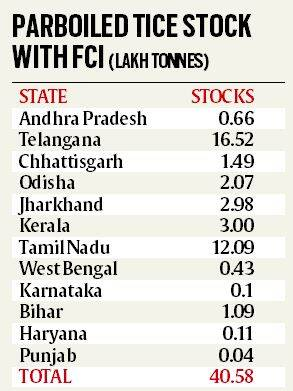
- Also, there is no demand for such grain under the Public Distribution System (PDS).
- The Ministry pegs the parboiled rice demand at 20 LMT per annum for distribution under the National Food Security Act, 2013.
- According to the Ministry, the demand for parboiled rice has come down in recent years.
- In the last few years, production in parboiled rice-consuming states such as Jharkhand, Kerala and Tamil Nadu has increased, resulting in less movement to the deficit states.
- Earlier, the Food Corporation of India used to procure parboiled rice from states such as Telangana to supply to these states. But in recent years, parboiled rice production has increased in these states.
- Telangana is a surplus parboiled producing region and does not consume parboiled rice, but only produces which is always surplus and delivered to FCI.
What are the Key Highlights about Rice?
- It is a kharif crop which requires high temperature (above 25°C) and high humidity with annual rainfall above 100 cm.
- Rice is grown in the plains of north and north-eastern India, coastal areas and the deltaic regions.
- West Bengal tops the list of rice-producing states followed by Uttar Pradesh and Punjab.
UPSC Civil Services Examination, Previous Year Questions (PYQs)
Q. With reference to the cultivation of Kharif crops in India in the last five years, consider the following statements: (2019)
- Area under rice cultivation is the highest.
- Area under cultivation of jowar is more than that of oilseeds.
- Area of cotton cultivation is more than that of sugarcane.
- Area under sugarcane cultivation has steadily decreased.
Which of the statements given above are correct?
(a) 1 and 3 only
(b) 2, 3 and 4 only
(c) 2 and 4 only
(d) 1, 2, 3 and 4
Ans: (a)
- Rice is one of the most important food crop. India has the largest area under rice cultivation.
- Hence, statements 1 and 3 are correct, and statements 2, 4 and 5 are not correct. Therefore, option (a) is the correct answer.
Q. Consider the following crops: (2013)
- Cotton
- Groundnut
- Rice
- Wheat
Which of these are Kharif crops?
(a) 1 and 4
(b) 2 and 3 only
(c) 1, 2 and 3
(d) 2, 3 and 4
Ans: (c)
- India has three cropping seasons i.e., Rabi, Kharif and Zaid. Rabi crops are sown in winter from October to December and harvested in summer from April to June.
- Kharif crops are grown with the onset of monsoon in different parts of the country and these are harvested in September-October.
- In between the Rabi and the Kharif seasons, there is a short season during the summer months known as the Zaid season. Some of the crops produced during ‘Zaid’ are watermelon, muskmelon, cucumber, vegetables and fodder crops.
- Kharif Crops: Rice, Maize, Sorghum, Pearl Millet or Bajra, Finger Millet or Ragi (cereals), Arhar (pulses), Soyabean, Groundnut (oilseeds), Cotton, etc. Hence, 1 ,2 and 3 are correct.
- Rabi Crops: Wheat, Barley, Oats (cereals), Chickpea or Gram (pulses), Linseed, Mustard (oilseeds), etc. Hence, 4 is not correct.
- Therefore, option (c) is the correct answer.


Social Justice
Polio
For Prelims: Polio, Universal Immunisation Programme, WHO.
For Mains: Government Policies & Interventions, Polio, its spread, vaccine and eradication measures.
Why in News?
With the possibility of a new Covid-19 variant triggering a fresh surge in cases, the Centre has told the states to send sewage samples to all sentinel sites that currently carry out surveillance of Poliovirus.
- Sentinel surveillance is the "monitoring of rate of occurrence of specific diseases/conditions through a voluntary network of doctors, laboratories and public health departments with a view to assess the stability or change in health levels of a population".
What is Polio?
- About:
- Polio is a crippling and potentially deadly viral infectious disease that affects the nervous system.
- There are three individual and immunologically distinct wild poliovirus strains:
- Wild Poliovirus type 1 (WPV1)
- Wild Poliovirus type 2 (WPV2)
- Wild Poliovirus type 3 (WPV3)
- Symptomatically, all three strains are identical, in that they cause irreversible paralysis or even death.
- However, there are genetic and virological differences, which make these three strains separate viruses which must each be eradicated individually.
- Spread:
- The virus is transmitted by person-to-person mainly through the faecal-oral route or, less frequently, by a common vehicle (for example, through contaminated water or food).
- It largely affects children under 5 years of age. The virus multiplies in the intestine, from where it can invade the nervous system and can cause paralysis.
- Symptoms:
- Most people with polio do not feel sick. Some people have only minor symptoms, such as fever, tiredness, nausea, headache, pain in the arms and legs, etc.
- In rare cases, polio infection causes permanent loss of muscle function (paralysis).
- Polio can be fatal if the muscles used for breathing are paralysed or if there is an infection of the brain.
- Prevention and Cure:
- There is no cure, but it can be prevented through Immunisation.
- Vaccines:
- Oral Polio Vaccine (OPV): It is given orally as a birth dose for institutional deliveries, then primary three doses at 6, 10 and 14 weeks and one booster dose at 16-24 months of age.
- Injectable Polio Vaccine (IPV): It is introduced as an additional dose along with the 3rd dose of DPT (Diphtheria, Pertussis and Tetanus) under the Universal Immunisation Programme (UIP).
- Recent Outbreaks:
- In 2019, polio outbreaks were recorded in the Philippines, Malaysia, Ghana, Myanmar, China, Cameroon, Indonesia and Iran, which were mostly vaccine-derived in which a rare strain of the virus genetically mutated from the strain in the vaccine.
- According to the WHO (World Health Organisation), if the oral vaccine-virus is excreted and allowed to circulate in an unimmunised or under-immunised population for at least 12 months, it can mutate to cause infections.
- In 2019, polio outbreaks were recorded in the Philippines, Malaysia, Ghana, Myanmar, China, Cameroon, Indonesia and Iran, which were mostly vaccine-derived in which a rare strain of the virus genetically mutated from the strain in the vaccine.
- India & Polio:
- India received polio-free certification by the WHO in 2014, after three years of zero cases.
- This achievement has been spurred by the successful Pulse Polio Campaign in which all children were administered polio drops.
- The last case due to wild poliovirus in the country was detected on 13th January 2011.
- India received polio-free certification by the WHO in 2014, after three years of zero cases.
What are the Polio Eradication Measures?
- Global:
- Global Polio Eradication Initiative:
- It was launched in 1988 by the Global Polio Eradication Initiative (GPEI), by national governments and World Health Organization (WHO). Presently, 80% of the world’s population is now living in certified polio-free regions.
- An estimated 1.5 million childhood deaths have been prevented, through the systemic administration of vitamin A during polio immunisation activities.
- It was launched in 1988 by the Global Polio Eradication Initiative (GPEI), by national governments and World Health Organization (WHO). Presently, 80% of the world’s population is now living in certified polio-free regions.
- World Polio Day:
- It is observed every year on 24th October in order to call on countries to stay vigilant in their fight against the disease.
- Global Polio Eradication Initiative:
- Indian:
- Pulse Polio Programme:
- It was started with an objective of achieving hundred percent coverage under Oral Polio Vaccine.
- Intensified Mission Indradhanush 2.0:
- It was a nationwide immunisation drive to mark the 25 years of Pulse polio programme (2019-20).
- Universal Immunization Programme (UIP):
- It was launched in 1985 with the modification to ‘Expanded Programme of Immunization (EPI).
- The objectives of the Programme include: Rapidly increasing immunisation coverage, Improving the quality of services, Establishing a reliable cold chain system to the health facility level, Introducing a district-wise system for monitoring of performance, Achieving self-sufficiency in vaccine production.
- Pulse Polio Programme:


Important Facts For Prelims
NCX India
Why in News?
Recently, the National Security Council Secretariat organised the National Cyber Security Incident Response Exercise (NCX India) .
- NCX India will be conducted as a hybrid exercise over a period of ten days from 18th to 29th April 2022.
- It is launched with the aim to train senior management and technical personnel of Government/Critical Sector organisations and agencies on contemporary cyber threats and handling cyber incidents and response.
What is the National Security Council?
- NSC of India is a three-tiered organisation that oversees political, economic, energy and security issues of strategic concern.
- The National Security Advisor (NSA) presides over the NSC and is also the primary advisor to the Prime Minister. The current National Security Advisor is Ajit Doval.
- It was formed in 1998, where all aspects of national security are deliberated upon.
What is NCX India?
- Platform: The platform for training is being provided by CyberExer Technologies, an Estonian cybersecurity company accredited for globally conducting several large cyber exercises.
- Need: Digital Revolution taking place in the country and the launch of a large number of digital services by the Government.
- In this context, Cyber Security remains the foundation of any successful Digital Transformation.
- Any threats in cyberspace directly impact our social, economic and National Security and thus, there is a need to safeguard our Cyberspace.
- Training Module: The participants will be trained on various key cyber security areas such as Intrusion Detection Techniques, Malware Information Sharing Platform (MISP), Vulnerability Handling & Penetration Testing, Network Protocols & Data Flows, Digital Forensics, etc.
- Envisaged Goal: NCX India will help strategic leaders to better understand cyber threats, assess readiness, and develop skills for cyber crisis management and cooperation.
- This will also help develop and test cybersecurity skills, teamwork, planning, communication, critical thinking, and decision-making.
What are Present Government Initiatives for Cyber Security?



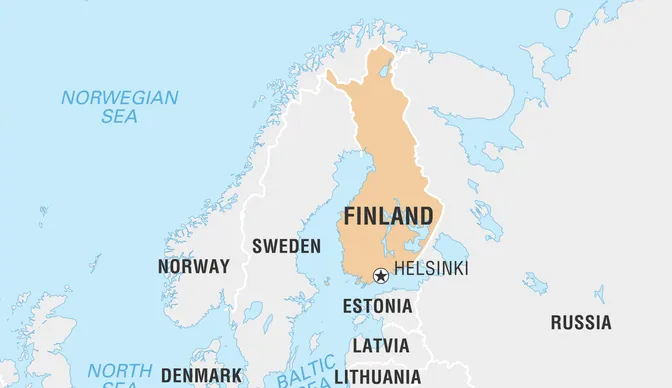
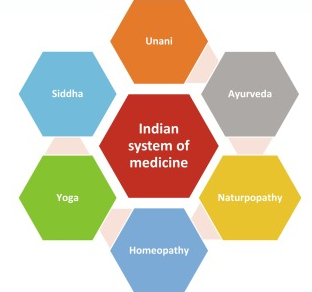
.png)
